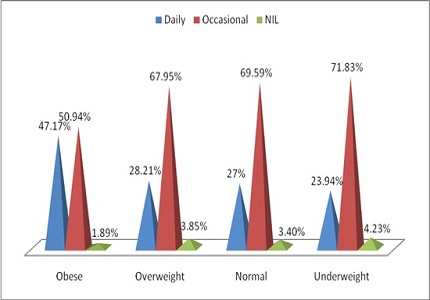Physical activity, sedentary behaviours and eating habits among school children in kerala
Abstract
Background: World Health Organization refers obesity as a global epidemic including children and adults. Low levels of physical activity, TV watching, and unhealthy food habits are risk factors for overweight and obesity in children.
Objective: To study the association between eating habits and physical activities and the risk of obesity in school children in Thrissur District, Kerala.
Materials and Methods: 1610 school children of the age group 5-10 years from 5 schools of rural and urban regions were selected by purposive sampling method. Pre-designed and pre-tested questionnaire was used to elicit the dietary history and physical activity. Height and weight were measured and BMI was calculated. Overweight and obesity were determined. Students who had BMI for age between 85 Th and 95 Th percentile of reference population were considered as overweight and BMI for age >95 Th percentile of reference population were considered as obese.
Results: The prevalence of obesity is found to be 3.3% and that of overweight is 4.8% in the study group. The prevalence of obesity is 4.47% and 1.98% in urban and rural school children respectively. Frequency of intake of fried foods, chocolates, Play hours <1hr and transport to school by vehicle has a significant influence on BMI.
Conclusion: The prevalence of obesity and overweight (BMI>85th Percentile) is significantly higher in urban school children compared to rural school children .Physical inactivity and increased intake of high calorie foods are the main causes for high prevalence.
Downloads
References
de Onis M, Blössner M. Prevalence and trends of overweight among preschool children in developing countries. Am J Clin Nutr. 2000 Oct;72(4):1032-9.
Sharma A, Sharma K, Mathur KP. Growth pattern and prevalence of obesity in affluent schoolchildren of Delhi. Public Health Nutr. 2007 May;10(5):485-91.
Stature- for-age charts for both gender developed by National Centre for Health Statistics in collaboration with the National Center for Chronic Disease Prevention and Health Promotion (2000).Website: www.cdc.gov/growthcharts/data/set2clinical/cj41c071.pdf.
BMI growth charts for age and gender developed by National Centre for Health Statistics in collaboration with the National Center for Chronic Disease Prevention and Health Promotion (2000). Website: www.cdc.gov/growthcharts/data/set2clinical/cj41c073.pdf .
Blood pressure percentiles charts adjusted for age, gender, and height percentile developed by the National Heart Lung and Blood Institute.Website: http://www.nhlbi.nih.gov/guidelines/hypertension/child_tbl.pdf .
Ramachandran A, Snehalatha C, Vinitha R, Thayyil M, Kumar CK, Sheeba L, Joseph S, Vijay V. Prevalence of overweight in urban Indian adolescent school children. Diabetes Res Clin Pract. 2002 Sep;57(3):185-90.
Kapil U, Singh P, Pathak P, Dwivedi SN, Bhasin S. Prevalence of obesity amongst affluent adolescent school children in delhi. Indian Pediatr. 2002 May;39(5):449-52.
A.G. Unnithan, S. Syamakumari: Prevalence of Overweight, Obesity and Underweight among School Going Children in Rural and Urban areas of Thiruvananthapuram Educational District, Kerala State (India). The Internet Journal of Nutrition and Wellness. 2008 Volume 6 Number 2.DOI: 10.5580/fcf
Yang X, Telama R, Viikari J, Raitakari OT. Risk of obesity in relation to physical activity tracking from youth to adulthood. Med Sci Sports Exerc. 2006 May;38(5):919-25.
Roberts C. Currie C, Morgan A, Smith R, Settertobulte W, Samdal O, Rasmussen VB, editors. Young people’s health in context: Health behavior in school-aged children (HSBC) study: International report from the 2001/2002 survey, Geneva: World Health Organization; 2004.
Strong WB, Malina RM, Blimkie CJ, Daniels SR, Dishman RK, Gutin B, Hergenroeder AC, Must A, Nixon PA, Pivarnik JM, Rowland T, Trost S, Trudeau F. Evidence based physical activity for school-age youth. J Pediatr. 2005 Jun;146(6):732-7.
International Olympic Committee. Final Declaration, 13th World Sport for All Congress. Jyväskylä, Finland .17 June 2010.
Organization for Economic Co-operation and Development. Obesity and the Economics of Prevention: Fit not Fat. Paris: OCDE; 7-8 October, 2010.
Andersen RE, Crespo CJ, Bartlett SJ, Cheskin LJ, Pratt M. Relationship of physical activity and television watching with body weight and level of fatness among children: results from the Third National Health and Nutrition Examination Survey. JAMA. 1998 Mar 25;279(12):938-42.
Hernandez B. Gortmaker SL. Colditz GA, Peterson KE. Laird NM. Parra-Cabrera S. Association of obesity with physical activity, television programs and other forms of video viewing among children in Mexico City. Int J Obes Relat Metab Disord 1999 Aug; 23(8): 845-54.
Robinson TN. Does television cause childhood obesity? JAMA. 1998 Mar 25;279(12):959-60.
Lobstein T, Baur L, Uauy R; IASO International Obesity TaskForce. Obesity in children and young people: a crisis in public health. Obes Rev. 2004 May;5 Suppl 1:4-104.
August GP, Caprio S, Fennoy I, Freemark M, Kaufman FR, Lustig RH, Silverstein JH, Speiser PW, Styne DM, Montori VM; Endocrine Society. Prevention and treatment of pediatric obesity: an endocrine society clinical practice guideline based on expert opinion. J Clin Endocrinol Metab. 2008 Dec;93(12):4576-99. doi: 10.1210/jc.2007-2458. Epub 2008 Sep 9.
Atkin LM, Davies PS. Diet composition and body composition in preschool children. Am J Clin Nutr. 2000 Jul;72(1):15-21.
Ludwig DS, Pereira MA, Kroenke CH, Hilner JE, Van Horn L, Slattery ML, Jacobs DR Jr. Dietary fiber, weight gain, and cardiovascular disease risk factors in young adults. JAMA. 1999 Oct 27;282(16):1539-46.
Hu FB, van Dam RM, Liu S. Diet and risk of Type II diabetes: the role of types of fat and carbohydrate. Diabetologia. 2001 Jul;44(7):805-17.
Borzekowski DL, Robinson TN. The 30-second effect: an experiment revealing the impact of television commercials on food preferences of preschoolers. J Am Diet Assoc. 2001 Jan;101(1):42-6.
Epstein LH, Paluch RA, Consalvi A, Riordan K, Scholl T. Effects of manipulating sedentary behavior on physical activity and food intake. J Pediatr. 2002 Mar;140(3):334-9.

Copyright (c) 2016 Author (s). Published by Siddharth Health Research and Social Welfare Society

This work is licensed under a Creative Commons Attribution 4.0 International License.


 OAI - Open Archives Initiative
OAI - Open Archives Initiative


